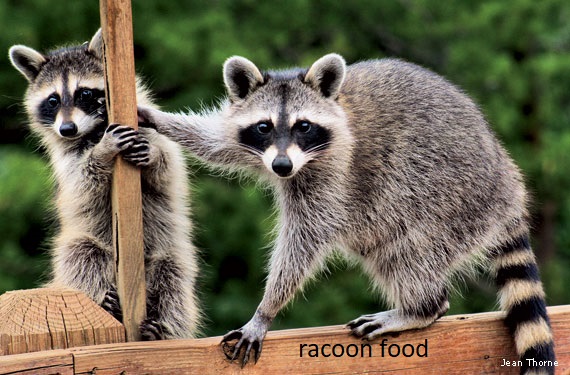Introduction
The masked criminals of the night, the racoon food are renowned for their foraging tendencies and food adaptation. In this article, we’ll examine the diverse diet of raccoons, from their foraging habits in the wild to their frequent scavenging in cities.
Nature’s Candy: Fruits and Berries
Racoon food enjoy the sweetness of fruits like berries, apples, and grapes in their native environments. These tasty morsels can be plucked from branches by their quick fingers and keen claws, making them excellent arboreal foragers.
Who Are Racoons?
North American native racoon food (Procyon lotor) are medium-sized mammals. Their unique black mask-like face features and bushy, ringed tails make them simple to identify. Due to their excellent adaptability and successful range expansion, these nocturnal animals are now frequently seen in both rural and urban regions.
Racoon Diet: An Overview
Being omnivorous means that racoon food have a varied diet that includes both plant and animal products. Their diet varies according on their surroundings, seasonal food availability, and access to quick meals.
What Do Racoons Eat in the Wild?
Fruits and Berries
They love foods including berries, apples, and grapes in their natural environments. They can reach branches with fruit because they are adept climbers.
Small Animals
They are opportunistic hunters who prey on rodents, birds, and amphibians in addition to other small creatures. To capture prey, they employ their razor-sharp claws and acute senses.
Aquatic Delights
They are known to feed water animals including fish, crayfish, and frogs and are skilled swimmers. These underwater snacks are easily caught by their nimble paws.
Insects and Grubs
They diet also includes a lot of grubs and insects. In order to find these protein-rich morsels, they frequently delve into the ground or decaying logs.
Racoon Diet in Urban Areas

-
Trash Can Treasures
Racoons food in urban areas adapt to their environment by robbing rubbish bins and skips. They are good scavengers since they can open lids and handle stuff.
-
Garden Raiding
Additionally, they have been known to plunder gardens, particularly when fresh produce is available. Among their preferred foods are ripe tomatoes and sweet corn.
-
Pet Food Pilfering
They have a history of stealing pet food that has been left outside, posing a threat to pet owners.
Health Implications of Racoon Diets
They are extremely adaptive, yet their propensity for scavenging in cities can have an adverse effect on their health and that of nearby residents. The spread of illnesses like rabies can be a serious problem.
Interesting Facts about Racoon Food Habits
- They have a reputation for being “clean” eaters since they are known to wash their food in water before eating.
- Their highly developed sense of touch allows them to investigate and work with a variety of foods.
- They are opportunistic feeders, and the seasons and the availability of food can affect their diet.
Racoon Food: How to Keep Them Away
There are gentle ways to keep racoon food away if they start to cause problems in your neighbourhood. Racoon food can be deterred from frequenting your property by using secure garbage cans, caulking entryways, and not leaving pet food outside.
The Hunter’s Delight: Small Animals
They are adept hunters who prey on rodents, birds, and amphibians among other tiny creatures. They are effective hunters in the wild thanks to their sharp senses and rapid reactions.
A Dive into Aquatic Feasts
Not only are these fuzzy creatures landlubbers, but they also make superb swimmers. Fish, crayfish, and frogs are among the aquatic delicacies that racoon food enjoy. Their underwater adventures show how adaptable they are when looking for food.
Unveiling the Racoon’s Diet Palette
They are opportunistic eaters, which means they don’t make a lot of food preferences. Their surroundings, the season, and the availability of food sources influence their nutrition. Let’s investigate what foods racoon food eat.
Conservation of Racoons

They are not currently listed as being threatened or endangered. To lessen human-wildlife conflicts, it is crucial to preserve their natural habitats and manage urban areas. Responsible waste management, protecting food sources, and acknowledging racoon food place in ecosystems are all necessary for coexisting with them.
The Role of Racoons in Ecosystems
They are crucial players in ecosystems because they ingest and disperse seeds. They contribute to seed distribution and the renewal of plant species by eating fruits and berries. Racoon food consume a variety of insects and invertebrates, which helps them regulate bug populations.
Conclusion
When it comes to their ability to adapt and be creative in their quest for food, racoon food are quite amazing animals. They are able to meet their nutritional needs whether they are in the wild or in urban jungles. It will be easier for humans to live in harmony with these intelligent animals if we are aware of their eating habits.
Frequently Asked Questions
Are racoons dangerous to humans?
While racoon food normally do not attack people, it is important to prevent contact since they can spread diseases like rabies.
What should I do if I encounter a racoon in my yard?
Keep your distance, and call animal control if the racoon food seems ill or hostile.


